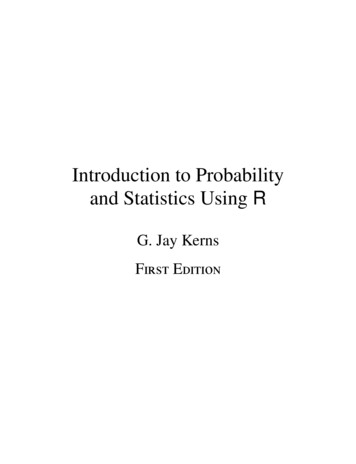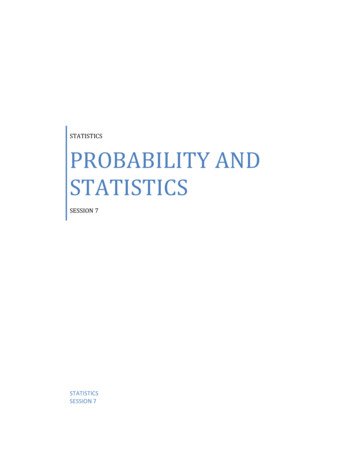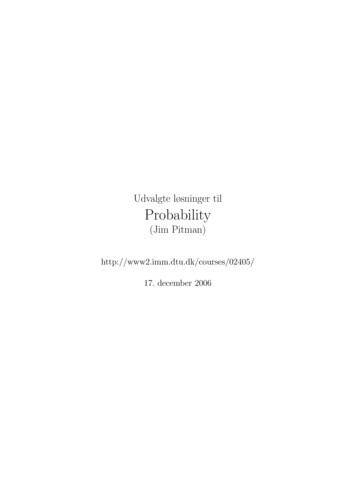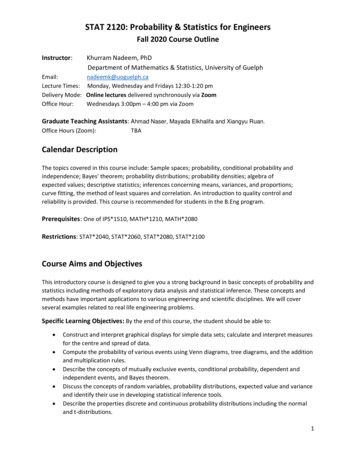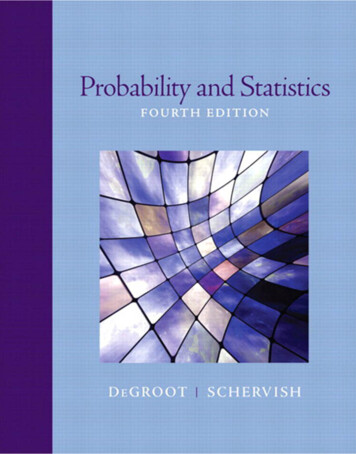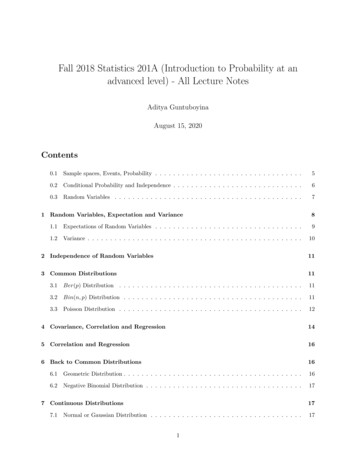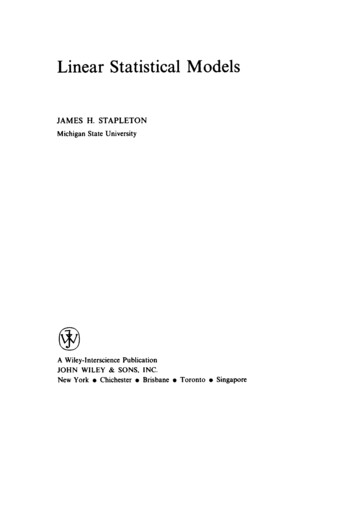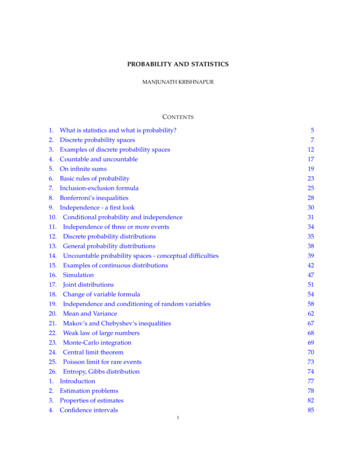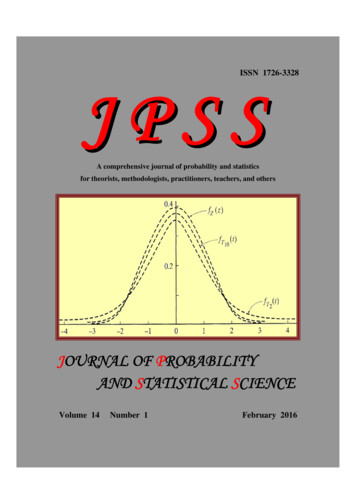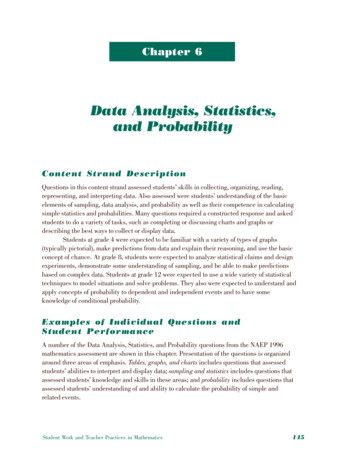
Transcription
Chapter 6Data Analysis, Statistics,and ProbabilityContent Strand DescriptionQuestions in this content strand assessed students’ skills in collecting, organizing, reading,representing, and interpreting data. Also assessed were students’ understanding of the basicelements of sampling, data analysis, and probability as well as their competence in calculatingsimple statistics and probabilities. Many questions required a constructed response and askedstudents to do a variety of tasks, such as completing or discussing charts and graphs ordescribing the best ways to collect or display data.Students at grade 4 were expected to be familiar with a variety of types of graphs(typically pictorial), make predictions from data and explain their reasoning, and use the basicconcept of chance. At grade 8, students were expected to analyze statistical claims and designexperiments, demonstrate some understanding of sampling, and be able to make predictionsbased on complex data. Students at grade 12 were expected to use a wide variety of statisticaltechniques to model situations and solve problems. They also were expected to understand andapply concepts of probability to dependent and independent events and to have someknowledge of conditional probability.Examples of Individual Questions andStudent PerformanceA number of the Data Analysis, Statistics, and Probability questions from the NAEP 1996mathematics assessment are shown in this chapter. Presentation of the questions is organizedaround three areas of emphasis. Tables, graphs, and charts includes questions that assessedstudents’ abilities to interpret and display data; sampling and statistics includes questions thatassessed students’ knowledge and skills in these areas; and probability includes questions thatassessed students’ understanding of and ability to calculate the probability of simple andrelated events.Student Work and Teacher Practices in Mathematics145
All sample questions from this content strand are mapped onto the NAEP mathematicsscale as shown in Figure 6.1. Specific instructions on how to interpret this map are given at theend of Chapter 2. The map is included to provide an indication of the relative difficulty of eachexample question and, thus, to indicate the type of material mastered within this content strandby students with varying degrees of mathematics proficiency. As noted in previous chapters,however, the difficulty of any question is a function of the relationship between characteristicsspecific to the question (e.g., format, absence or presence of graphics, real-world application),the specific mathematics content associated with the question, and students’ opportunities tolearn this content. It should be remembered also that overall performance on the Data Analysis,Statistics, and Probability content strand is not determined solely by performance on theexamples presented here. These examples illustrate only some of what students know andcan do.146Student Work and Teacher Practices in Mathematics
Figure 6.1Map of Selected Data Analysis, Statistics, andProbability Questions on the NAEP CompositeMathematics Scale (Item Map)NAEP ScaleNOTE: Position of questions is approximate.(8) Recognize Misleading Graph (475)(463) Compare Mean and Median (12)(12) Use Data in Table to Compute Average Hourly Wageand Determine When Wage Rate Changes (420)(411) Compare Probabilities (12)Grade 12Average:(12) Use Data from a Chart (295)(8) Use Data from a Chart (286)Grade 8Average:(289) Identify Representative Sample (8)(278) Determine a Probability (4)(265) Use Data from a Chart (4)(246) Read a Bar Graph (4)(8) Reason About Sample Space (235)Grade 4Average:NOTE: Each mathematics question was mapped onto the NAEP 0 to 500 mathematics scale. The position of the question on thescale represents the scale score obtained by students who had a 65 percent probability of successfully answering the question.(The probability was 74 percent for a 4-option multiple-choice question and 72 percent for a 5-option multiple-choice question.)Only selected questions are presented. The number 4, 8, or 12 in parentheses is the grade level at which the question was asked.SOURCE: National Center for Education Statistics, National Assessment of Educational Progress (NAEP) 1996Mathematics Assessment.Student Work and Teacher Practices in Mathematics147
Tables, graphs, and chartsThese questions assessed students’ abilities to interpret and display data in tables, graphs, andcharts. At all grade levels, students had to read and interpret data, make predictions, computewith data, and interpolate and extrapolate. They also had to translate data into tables andgraphs. Questions for fourth-grade students often used pictographs, with symbols representingsingle or multiple units. Fourth-grade students also were evaluated on their ability to interpretsimple pie charts. Questions for older students included stem-and-leaf and box-and-whiskerplots. Graphs and charts often involved percents, and graphs often compared units on twodimensions. Students in eighth and twelfth grade were asked to make decisions about the bestrepresentation of data for certain situations or to compare data in two different tables, graphs,or charts.Four examples of questions are presented here — one at each grade level and one thatappeared at all three grade levels. The first example is a multiple-choice question thatappeared on the assessment for fourth-grade students. The question presented students with abar graph representing class votes on favorite types of music. Results for three types of musicand a residual “other” category were displayed separately for boys and girls. A legend indicatedthat the square symbol used in the graph represented one student. Students were to determinethe type of music preferred by most of the students in the class. In order to respond correctly,students had to add the number of votes for boys and girls together within categories andcompare the totals.The correct option is B.148Student Work and Teacher Practices in Mathematics
This question was not very difficult for fourth-grade students. It mapped at a score of246 on the NAEP composite mathematics scale. Student performance data are presented inTables 6.1 and 6.2. Nearly 60 percent of the students responded correctly to the question.Another 36 percent of the students chose Option C (country music) as the appropriate response.These students may not have understood that they had to sum the data for girls and boys andmay have simply chosen the category with the longest bar. Table 6.2 shows that approximatelytwo-thirds of the students at the Basic achievement level and more than 80 percent of those atthe Proficient level responded correctly to the question.Table 6.1Percentage Correct for “Read a Bar Graph”Percentage CorrectGrade Pacific IslanderAmerican Indian673345********* Sample size is insufficient to permit a reliable estimate.SOURCE: National Center for Education Statistics, National Assessment of Educational Progress (NAEP) 1996Mathematics Assessment.Table 6.2Percentage Correct Within Achievement-LevelIntervals for “Read a Bar Graph”NAEP Grade 4 Composite Scale RangeOverallBelow BasicBasicProficientAdvanced59386682****** Sample size is insufficient to permit a reliable estimate.SOURCE: National Center for Education Statistics, National Assessment of Educational Progress (NAEP) 1996Mathematics Assessment.Student Work and Teacher Practices in Mathematics149
The second example for this area was a question that appeared on the assessment for allthree grade levels. It is a short constructed-response question for which students had tointerpret data from a table and then explain their interpretation. The data in this question againrepresented votes, this time regarding shapes that were being considered for a class symbol.(The question fell within a block for which students were supplied with cardboard shapes ormanipulatives. The designations N, P, and Q that are used in the question refer to theseshapes.) Based on the preference data from three classes, students were to determine whichshape should be selected for the symbol and tell why. The correct response was shape Nbecause it received more total votes than the other two shapes; students also could have statedthat it was the first choice in one class and the second choice in the others.150Student Work and Teacher Practices in Mathematics
A sample “correct” response follows. In this response, the student chose shape N,supporting this choice by adding up the total number of votes for each shape and showing thatshape N received the most votes overall.Sample “correct” responseThese next two samples are “incorrect” responses. In the first, the student correctlychose shape N but provided an incorrect explanation. It is followed by a sample response from astudent who chose shape Q.Sample “incorrect” response 1Student Work and Teacher Practices in Mathematics151
Sample “incorrect” response 2This question was somewhat difficult for students in grade 4 but easier for students ingrades 8 and 12. The performance results are displayed in Tables 6.3 and 6.4. Table 6.3 showsthe percentage of students at each grade who 1) chose shape N and had a correct explanation,2) who chose shape N but had no or an incorrect explanation, 3) who chose shape Q, and 4) whomade some other incorrect response.1 Only the responses of students who chose shape N andhad a correct explanation were rated “correct.”Approximately one-third of the fourth-grade students, one-half of the eighth-gradestudents, and two-thirds of the twelfth-grade students chose shape N for the symbol and hadcorrect explanations. At each of the three grades, the percentage of students who chose shape Nbut had no or incorrect explanations was between 12 and 17 percent. Perhaps the mostinteresting difference was in the percent of students who chose shape Q. Thirty-two percent ofthe fourth-grade students (equivalent to the percentage who answered correctly) chose shape Q.At grade 8, this percentage dropped by half, and at grade 12, only nine percent of the studentschose shape Q. At the earlier grades, students may be more inclined than at later grades simplyto base their response on the largest single number in the table rather than to sum the dataacross classes. Another possible explanation is that, at the fourth-grade level, students simplyanswered their favorite shape.1Student responses for this and all other constructed-response questions also could have been scored as “off task,” whichmeans that the student provided a response, but it was deemed not related in content to the question asked. There aremany examples of these types of responses, but a simple one would be “I don’t like this test.” Responses of this sortcould not be rated. In contrast, responses scored as “incorrect” were valid attempts to answer the question that weresimply wrong.152Student Work and Teacher Practices in Mathematics
Table 6.3Score Percentages for “Use Data from a Chart”CorrectIncorrectOmitShape N–CorrectExplanationShape N–No,or Incorrect,ExplanationShape teBlackHispanicAsian/Pacific IslanderAmerican 1000!643852– –***15209– –***132120– –***72019– –***0!20!– ific IslanderAmerican Indian70585567***18152114***716910***Geometry Taken6818851Highest Algebra-CalculusCourse Taken:Pre-AlgebraFirst-Year AlgebraSecond-Year AlgebraThird-Year 1086109655432010Grade 4OtherGrade 8WhiteBlackHispanicAsian/Pacific IslanderAmerican IndianMathematics Course Taking:Eighth-Grade MathematicsPre-AlgebraAlgebraGrade 1248127***1242***NOTE: Row percentages may not total 100 due to rounding. Responses that could not be rated were excluded.*** Sample size is insufficient to permit a reliable estimate.– – Data for grade 8 Asian/Pacific Islanders are not reported due to concerns about the accuracy and precision of thenational estimates. See Appendix A for further detail.! Statistical tests involving this value should be interpreted with caution. Standard error estimates may not be accuratelydetermined and/or the sampling distribution of the statistics does not match statistical test assumptions (see Appendix A).SOURCE: National Center for Education Statistics, National Assessment of Educational Progress (NAEP) 1996Mathematics Assessment.Student Work and Teacher Practices in Mathematics153
Table 6.4 shows, for each grade, the percentage of students within each of the NAEPachievement levels who responded correctly to the question. At grade 4, only students who wereat least at the Proficient level had a greater than 50 percent chance of answering correctly. Atgrade 8, more than two-thirds of students at the Basic level provided “correct” responses, and atgrade 12, even students below the Basic level had a 50 percent chance of correct response. Thequestion mapped at a score of 265 on the NAEP composite mathematics scale for grade 4students. At grade 8, the question mapped at 286, and at grade 12, the question mapped at 295.Table 6.4Percentage Correct Within Achievement-LevelIntervals for “Use Data from a Chart”NAEP Grades 4, 8, and 12 Composite Scale RangesGrade 4Grade 8Grade 12OverallBelow 7************ Sample size is insufficient to permit a reliable estimate.SOURCE: National Center for Education Statistics, National Assessment of Educational Progress (NAEP) 1996Mathematics Assessment.The third sample for this area is an extended constructed-response question foreighth-grade students. Students were presented with two graphs displaying the number of ridersfor the Metro Rail Company over a 6-month period. The difference between the graphs was thatone displayed the scale for the number of riders in increments of 2,000 while the otherdisplayed the scale in increments of 100. The question itself had two components, althoughthese were scored together to provide a single rating for the question. First, students wereinstructed to choose, and justify their choice for, the graph that would best convince others thatthe Metro Rail Company made a lot more money from ticket sales in March than in October.Second, students were asked to explain why some people might consider the graph they choseto be misleading.154Student Work and Teacher Practices in Mathematics
Student Work and Teacher Practices in Mathematics155
The correct answer for the first part of the question was Graph B because itappeared to show a large increase from October to March. Acceptable variations on thisexplanation included: The line in Graph B goes up more, has a more dramatic rise, or climbs higher. Graph B climbs faster. Graph B is steeper. Graph B shows a larger visual increase.For the second part of the question, students were expected to recognize that Graph Bmight be considered misleading because it exaggerated a relatively small increase in ridership(misuse of scale). Acceptable variations of this reason included: Graph B has a smaller scale. Graph A has a larger scale. The numbers on B are smaller than those on A (they increase by 100s not 1,000s).The use of the term “range” instead of “scale” was not considered acceptable.156Student Work and Teacher Practices in Mathematics
Student responses were considered “correct” if they identified B as the best graph andhad a complete explanation for both parts of the question. An example of a “correct” responsefollows. In this example, the student used the term “range” in both answers, which would not,in itself, be considered “correct”; however, the student also said that Graph B should be chosenbecause it climbs faster and is misleading because it only has 100 at a time. Both of thesestatements were considered “correct” responses.Sample “correct” responseStudent Work and Teacher Practices in Mathematics157
Student responses were rated as “partial” if they chose Graph B and had an incomplete,but partially correct, explanation for one or both parts of the question. For example, in thefollowing sample response the student gave a complete explanation of why B should be chosen,but an incomplete explanation of why Graph B could be considered misleading. When thequestion was anchored to the NAEP scale, the “correct” and “partial” rating categorieswere collapsed.Sample “partial” response158Student Work and Teacher Practices in Mathematics
Students also could have had responses that identified Graph B as the best graph butoffered no explanations or only incorrect explanations. Answers of this type, which areillustrated in the following example, were rated as “minimal.”Sample “minimal” responseStudent Work and Teacher Practices in Mathematics159
Student responses, such as the following, that did not identify B as the best graph wererated “incorrect.”Sample “incorrect” responseTable 6.5 shows that only 2 percent of the students chose Graph B and gave completeexplanations, while 19 percent chose Graph B and gave incomplete, but partially correct,explanations for at least one part of the question. However, 35 percent of the eighth-gradestudents who were taking algebra were able to provide at least partially correct explanations forchoosing Graph B. This was a higher percentage than was obtained for students enrolled inpre-algebra or eighth-grade mathematics. Overall, 30 percent of the students did not evenattempt the question.160Student Work and Teacher Practices in Mathematics
Score Percentages for“Recognize Misleading Graph”Table 6.5CorrectGraph B–CompleteExplanationPartialGraph B–Incompletebut PartiallyCorrect ExplanationMinimalGraph B–No or IncorrectExplanationIncorrectOmitGrade n/Pacific IslanderAmerican IndianMathematics Course Taking:Eighth-Grade : Row percentages may not total to 100 due to rounding. Responses that could not be rated were excluded.*** Sample size is insufficient to permit a reliable estimate.– – Data for grade 8 Asian/Pacific Islanders are not reported due to concerns about the accuracy and precision of thenational estimates. See Appendix A for further detail.! Statistical tests involving this value should be interpreted with caution. Standard error estimates may not be accuratelydetermined and/or the sampling distribution of the statistics does not match statistical test assumptions (see Appendix A).SOURCE: National Center for Education Statistics, National Assessment of Educational Progress (NAEP) 1996Mathematics Assessment.Table 6.6 shows that 35 percent of the eighth-grade students who were classified asProficient on the NAEP composite mathematics scale, 22 percent of the students classified asBasic, and only 7 percent of the students classified as performing below Basic chose Graph Band responded with at least partially correct explanations to the two parts of the question. Thequestion mapped at a score of 475.Percentage at Least Partial WithinAchievement-Level Intervals for“Recognize Misleading Graph”Table 6.6NAEP Grade 8 Composite Scale RangeOverall20Below Basic7BasicProficientAdvanced2235****** Sample size is insufficient to permit a reliable estimate.SOURCE: National Center for Education Statistics, National Assessment of Educational Progress (NAEP) 1996Mathematics Assessment.Student Work and Teacher Practices in Mathematics161
The final example for this area is a short constructed-response question that was used atgrade 12. The question presented a table summarizing time of day and number of hours worked,average hourly wage, and daily earnings for an individual on each of 5 days. For the fourth day,the cells for average hourly wage and total earnings were left blank. As in the previous example,this question had two parts that were considered together in determining the student’s score. Inthe first part, students were given the total earnings for all 5 days and asked to use thisinformation, in conjunction with the table, to determine the average hourly wage for day 4. Torespond correctly, students had to add the daily earnings for the 4 days presented ( 119.00),subtract this from the total earnings of 153.50, and divide by the total number of hours workedon the fourth day. This yielded the correct answer of 5.75. For the second part of the question,students were to use the information on time of day and number of hours worked, along with theaverage hourly rate, to determine the time of day at which the hourly rate changed. The correctanswer was 5:00 p.m.162Student Work and Teacher Practices in Mathematics
Student responses were rated “correct,” “partial,” or “incorrect.” “Correct” responsesidentified both the correct hourly wage and the correct time of the rate change. “Partial”responses identified either the correct average hourly wage or the correct time of the ratechange, and “incorrect” responses did not correctly identify either. Following are three sampleresponses. The first two responses were rated “partial”; each student correctly computed theaverage hourly wage for the fourth day, but in the second part of the question the firstrespondent entered the total daily earnings for day 4 instead of the time of the rate change, andthe second respondent entered 2:00 (the time the individual started work on day 4).Sample “partial” response 1Sample “partial” response 2Student Work and Teacher Practices in Mathematics163
The third sample response was rated “incorrect.” This student entered the total dailyearnings for the fourth day as a response to the first question and identified 3:00 p.m. as thetime of the rate change.Sample “incorrect” responsePerformance data are presented in Tables 6.7 and 6.8. Thirteen percent of studentsanswered both parts of the question correctly, whereas 43 percent responded correctly to one ofthe two parts. Students who had taken calculus were more likely to respond correctly thanstudents who had not taken calculus, and students who had taken at least third-year algebra orpre-calculus were more likely than those who had taken less mathematics to provide at least apartially correct response.164Student Work and Teacher Practices in Mathematics
Table 6.7Score Percentages for “Use Data in Table toCompute Average Hourly Wage and DetermineWhen Wage Rate Changes”CorrectPartialIncorrectOmitGrade ckHispanicAsian/Pacific IslanderAmerican try 2Highest Algebra-CalculusCourse Taken:Pre-AlgebraFirst-Year AlgebraSecond-Year AlgebraThird-YearAlgebra/Pre-CalculusCalculusNOTE: Row percentages may not total 100 due to rounding. Responses that could not be rated were excluded.*** Sample size is insufficient to permit a reliable estimate.SOURCE: National Center for Education Statistics, National Assessment of Educational Progress (NAEP) 1996Mathematics Assessment.The question mapped at a score of 420. Twenty-three percent of the studentsclassified as Proficient and 14 percent of those classified as Basic were credited with a fullycorrect response.Table 6.8Percentage Correct Within Achievement-LevelIntervals for “Use Data in Table to ComputeAverage Hourly Wage and Determine When WageRate Changes”NAEP Grade 12 Composite Scale RangeOverall13Below Basic4BasicProficientAdvanced1423****** Sample size is insufficient to permit a reliable estimate.SOURCE: National Center for Education Statistics, National Assessment of Educational Progress (NAEP) 1996Mathematics Assessment.Student Work and Teacher Practices in Mathematics165
Sampling and statisticsQuestions in this area, which appeared primarily on the instruments for eighth- andtwelfth-grade students, assessed students’ understanding of and ability to apply sampling theoryand statistical analyses. Students were asked questions regarding sampling, datarepresentation, and data summarization. They were evaluated on their understanding of thevarious measures of central tendency as well as on their ability to calculate these measures.Students also needed to understand concepts related to correlation. Three questions arepresented here. Two were eighth-grade multiple-choice questions, and one was a twelfth-gradeextended constructed-response question.The first eighth-grade question assessed students’ understanding of what can happenwhen a sample is taken. Students were told that a bag contained two red candies and one yellowcandy and that each of two persons took one candy out of the bag, without replacement. Thequestion then listed four combinations of candy colors and asked which combinations couldhave been drawn by these two people, given the candies in the bag. Only the fourthcombination, both picking yellow candies, was not possible.Table 6.9 presents the percentages of students responding correctly to none, one, two,three, or all four of the statements of sampling possibilities. Nearly 80 percent respondedcorrectly to all four statements, and another 10 percent responded correctly to at least three ofthe statements. More females than males responded correctly to all four questions. When thequestion was anchored to the NAEP scale, the categories of none, one, or two correct responsesto statements were collapsed.166Student Work and Teacher Practices in Mathematics
Score Percentages for“Reason About Sample Space”Table 6.9Number 11942842100WhiteBlackHispanicAsian/Pacific IslanderAmerican 16––***043––***0!0!0!––***Mathematics Course Taking:Eighth-Grade 00Grade 8NOTE: Row percentages may not total 100 due to rounding. Responses that could not be rated were excluded.*** Sample size is insufficient to permit a reliable estimate.– – Data for grade 8 Asian/Pacific Islanders are not reported due to concerns about the accuracy and precision of thenational estimates. See Appendix A for further detail.! Statistical tests involving this value should be interpreted with caution. Standard error estimates may not be accuratelydetermined and/or the sampling distribution of the statistics does not match statistical test assumptions (see Appendix A).SOURCE: National Center for Education Statistics, National Assessment of Educational Progress (NAEP) 1996Mathematics Assessment.This question was very easy for eighth-grade students. Table 6.10 shows that at leastthree-quarters of the students who performed below the Basic level on the NAEP mathematicsassessment gave the correct response to at least three statements, as did nearly all of thestudents in the other achievement level categories. The question mapped at a score of 235.Table 6.10Percentage with at Least Three Correct WithinAchievement-Level Intervals for“Reason About Sample Space”NAEP Grade 8 Composite Scale RangeOverall89Below Basic75BasicProficientAdvanced9799!100!! Statistical tests involving this value should be interpreted with caution. Standard error estimates may not be accuratelydetermined and/or the sampling distribution of the statistics does not match statistical test assumptions (see Appendix A).SOURCE: National Center for Education Statistics, National Assessment of Educational Progress (NAEP) 1996Mathematics Assessment.Student Work and Teacher Practices in Mathematics167
The second example for this area is also an eighth-grade multiple-choice question. Thisquestion assessed students’ understanding of what constitutes a representative sample.Students were told that a poll was being taken at a junior high school to determine the schoolmascot and were asked where they could find a sample of students to interview that was mostrepresentative of the students in the school.The correct option is B.This question also was fairly easy for eighth-grade students. Table 6.11 shows that65 percent of the students answered correctly. One percent of the students chose Option D, theFrench class, while approximately 10 percent of the students chose each of the remaining threeoptions. The question mapped at a score of 289, and most of the students whose performancewas classified as Basic or above chose the correct option.168Student Work and Teacher Practices in Mathematics
Percentage Correct for“Identify Representative Sample”Table 6.11Percentage CorrectGrade Pacific IslanderAmerican Indian734847––***Mathematics Course Taking:Eighth-Grade MathematicsPre-AlgebraAlgebra596774*** Sample size is insufficient to permit a reliable estimate.– – Data for grade 8 Asian/Pacific Islanders are not reported due to concerns about the accuracy and precision of thenational estimates. See Appendix A for further detail.SOURCE: National Center for Education Statistics, National Assessment of Educational Progress (NAEP) 1996Mathematics Assessment.Table 6.12Percentage Correct Within Achievement-LevelIntervals for “Identify Representative Sample”NAEP Grade 8 Composite Scale RangeOverall65Below Basic43BasicProficientAdvanced728796!! Statistical tests involving this value should be interpreted with caution. Standard error estimates may not be accuratelydetermined and/or the sampling distribution of the statistics does not match statistical test assumptions (see Appendix A).SOURCE: National Center for Education Statistics, National Assessment of Educational Progress (NAEP) 1996Mathematics Assessment.Student Work and Teacher Practices in Mathematics169
The final example for this area is an extended constructed-response quest
These questions assessed students' abilities to interpret and display data in tables, graphs, and charts. At all grade levels, students had to read and interpret data, make predictions, compute with data, and interpolate and extrapolate. They also had to translate data into tables and graphs.
